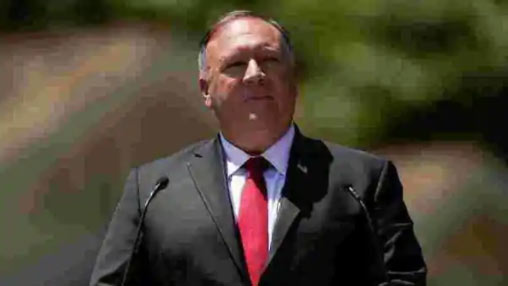
Opinion | The US is belatedly facing up to the ugly truth about shifty China
Secretary of state Pompeo admits that America’s had a misguided China strategy for half a century.
On 23 July, US secretary of state Mike Pompeo delivered a speech that is the clearest admission ever by a top US official that his country’s leadership had followed a wrong China strategy for half a century. And to say this, Pompeo chose the Richard Nixon Presidential Library and Museum as a venue. President Nixon began the current US-China relationship in 1971, after 22 years of hostility.
Pompeo said that US policymakers had presumed for decades “that as China became more prosperous, it would open up, it would become freer at home, and indeed present less of a threat abroad”. They had been totally mistaken. “And if we don’t act now,” said Pompeo, “ultimately the Chinese Communist Party (CCP) will…subvert the rules-based order that our societies have worked so hard to build. If we bend the knee now, our children’s children may be at the mercy of the CCP, whose actions are the primary challenge today in the free world.”
Secretary of state Henry Kissinger visited China in 1971, and soon after, the US began providing financial and military assistance. In the late 1970s, Deng Xiaoping realized that to prosper, China needed to obtain knowledge and skills from the US, the key being technology. In 1979, Deng and President Jimmy Carter signed agreements that led to the US providing China, as analyst Michael Pillsbury put it, “the greatest outpouring of American scientific and technological expertise in history”. The next year, the US granted China most-favoured-nation status as a trading partner. Wrote Pillsbury in 2015: “There is no available accounting of all the activities funded by the US government to aid China. Not only is America funding its chief opponent, it doesn’t even keep track of how much is being spent to do it.”
In the 1980s, the Ronald Reagan administration funded and trained new Chinese state-run institutes specializing in high-tech areas, from genetic engineering to intelligent robotics. US companies began investing in China, agreeing (or being coerced) to transfer often-proprietary technology to Chinese firms. Wall Street bankers grew mega-rich while raising billions of dollars for Chinese companies, many of them dubious, with very few following transparent accounting norms.
Americans paid no attention to the fact that Chinese textbooks continued to portray the US as a hegemon that, for more than 150 years, had tried to stifle China’s rise. Or that the Chinese National Museum in Beijing, where the CCP tells its version of Chinese history, consistently shows America as an evil power. The list of anti-China US presidents showcased range from Abraham Lincoln (who surely didn’t have much time to think about China) to—incredibly—Nixon. The US ignored Document 9, a 2013 CCP position paper that stated that the belief that “freedom, democracy and human rights are universal” is an attack on the foundations of the CCP, and “promoting Western constitutional democracy” is an “attempt to undermine… the socialism-with-Chinese-characteristics system of governance”.
Soon after the terror attacks of 9 September 2001, The Telegraph of London reported that “the Chinese state-run propaganda machine is… producing books, films and video games glorifying the strikes as a humbling blow against an arrogant nation”. The State-owned Beijing Television produced a documentary, Attack America, in which, over the video of the jets crashing into the World Trade Centre, the narrator says: “This is the America the whole world has wanted to see. Blood debts have been repaid with blood.” Yet, a mere three months after 9/11, China achieved its dream of admission to the World Trade Organization (WTO), principally due to strong US support. Since then, it has repeatedly flouted WTO rules.
The People’s Liberation Army’s (PLA’s) cyber warfare division, Unit 6139, has been found to be hacking into vital US computer systems for years, from its department of defence to Google and AT&T, and stealing data and technology. The J-20, the PLA’s answer to the American stealth fighter jet F-35, may have been developed with F-35 designs stolen from the US. But when Chinese President Xi Jinping visited the US in 2015, Barack Obama agreed to Chinese demands not to raise the issues of intellectual property theft and the PLA’s cyber attacks.
Last month, Christopher Wray, director of the Federal Bureau of Investigation, described Chinese stealing of scientific research from US industry and academia as “theft on a scale so massive that it represents one of the largest transfers of wealth in human history”. In one case, Chinese scientist Hongjin Tan alone was found to have stolen over $1 billion worth of trade secrets from his employer, a petroleum company, before getting caught.
But none of this is a great revelation to any China watcher. These facts have been known for years, if not decades. The only mystery is why the US government took so long to wake up. As Pompeo put it, “Perhaps we were naive about China’s virulent strain of communism, or triumphalist after our victory in the Cold War, or cravenly capitalist, or hoodwinked by Beijing’s talk of a ‘peaceful rise’.” Whatever the reason, it is good news for the world that America is finally facing the truth about Beijing.
Sandipan Deb is a former editor of ‘Financial Express’, and founder-editor of ‘Open’ and ‘Swarajya’ magazines.
Source: https://www.livemint.com/